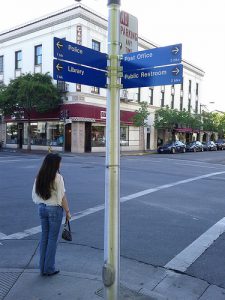
Palo Alto’s parking shortage may not be at an end quite yet – but there’s a plan. From Eric Fischer.
More than a year after beginning a comprehensive review of parking policies for its downtown, the city council of Palo Alto, CA, introduced two proposals for a residential parking permit program. The program aims to alleviate the stress of severe parking shortages that have caused heartache for workers, businesses, and residents adjacent to the downtown.
Residential parking spots gone
As that section of the city has flourished, residential areas that surround the city’s core — Professorville and Downtown North, for instance — have watched on-street parking in their neighborhoods disappear. They say the shrinkage is due to visitors and workers who, unable to find free street parking downtown and unwilling to pay for parking at lots or garages, seek spots in nearby neighborhoods.
One factor girding the issue is the city’s curbside parking regulations: There’s a two-hour time limit per spot, but curbside parking is otherwise free. That policy has helped businesses, merchants say, and, indeed, the numbers support their claim: New non-residential development in the area recently hit 235,000 square feet.
In 1986, the city council decided that figure would trigger public review of downtown development policies, so it is now studying the effects of the area’s recent developments, vacancy rates, and the possibility of new or revised zoning regulations.
Study underway of Palo Alto’s parking permit system & needs
The study is expected to conclude in the middle of 2014, but in the meantime, the council has made parking a priority on its agenda. It has already held several public meetings on the issue, but last week’s meeting was the first to discuss two versions of a residential parking permit program unveiled by the city.
The forty or so attendees at the meeting listened as presenters described the program, which would essentially extend the color parking zones already in place for the downtown core of University, Lytton, and Hamilton avenues to almost every downtown road from Alma to Guinda streets. In many of the zones, vehicles without hangtags would be subject to a two-hour time limit; those with parking permits would be allowed to park in specified zones with no time restrictions.
Residences would be able to receive up to two permits, as would some employees. A ratio has yet to be determined, but up to 40 percent of the permits could be set aside for non-residents, said interim planning director Aaron Aknin. Permit costs have yet to be decided as well.
Finding parking in Palo Alto is notoriously difficult, at least in part due to conflicts between commuters and residents. From Cyclelicious.
The difference between the two proposals presented by the city comes down to the number of new parking zones. In Concept A, ten zones would be added to those already exist. In Concept B, seventeen zones would be added. The latter is based on a failed concept the city considered in 2000—too pricey to implement, it said at the time. Today costs don’t play as large a role in the city’s decision-making process, though it hopes to recover some costs through the permits.
For the next two weeks, staff is soliciting feedback on the proposals. The city will the send surveys to determine residents’ interest, and if 50 percent of residents in a neighborhood are supportive, staff will bring the proposal to the city council for approval before the end of the year.